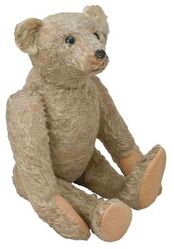| Margarete Steiff's Bear | |
|---|---|

| |
|
Origin |
Margarete Steiff |
|
Type |
Stuffed Bear |
|
Effects |
Provides strength to children in need |
|
Downsides |
N/A |
|
Activation |
Proximity to infirm children |
|
Collected by |
|
|
Section |
|
|
Date of Collection |
1910 |
| [Source] | |
Origin[]
Born in Giengen, Germany, at eighteen months old Margarete contracted polio and was to be affected by the illness for the rest of her life. Both of her feet suffered paralysis and she had restricted use of her right arm. Her parents were keen for her to live a full life and investigated many medical treatments with little success. Despite her disabilities Margarete regularly attended school throughout her childhood and it was in the needlework classes of Frau Schelling that she learnt her future profession, even though sewing without the full use of both hands must have presented difficulties.
Later Margarete attended needlework classes at the Giengen Town Hall, and became an accomplished zither player, teaching others to play to earn some money. Her savings allowed her to buy a sewing machine, the first owned in the town of Giengen, and this led to another opportunity to earn income. Margarete was often working on trousseaus for the town folk and by her mid twenties was making fashionable clothes and travelling to other towns to work and visit family, sending her cart ahead of her and travelling by Post-Coach.[2]
In 1877 Margarete opened a felt store and began making felt underskirts, which had just become fashionable, for the firm of Christian Siegle in Stuttgart. She was soon able to employ people to work for her and it became a thriving business. 'At this time I came across a pattern for a toy elephant. Felt was the ideal material for this toy and the filling would be of the finest lambswool. Now I could make these as gifts for the children in the family and I tried out the patterns in various sizes'. Margarete made many of these toys and gave them as gifts to friends, and by 1880 she started to sell them in small numbers.
Margarete Steiff made up all the samples of any new toys herself so she could be aware of any problems that might arise in production. Between 1897 and 1899 the Steiff company was designing and making 'dancing bear' toys. By 1903 the soft toy bears were given movable joints and a large shipment of toys had been sent to a New York showroom, but there was not much interest in the plush toy bears that were displayed there. In March 1903 Richard Steiff took jointed soft toy bears to a spring fair in Leipzig and they caught the eye of an American buyer, who ordered 3000. The Steiff bear went on to become the most famous and sought after make of teddy bears growing from one woman's determination to overcome disabilities and to create a business based on her needlework skills.
Effects[]
When in the presence of a child suffering from physical or mental disadvantages the effects will activate. The bear will cling to the child, providing temporary relief. Physically disabled children regain use of limbs and those with neurodivergant symptoms will be given a clear and focused mind.
The effects do not cure their conditions are are only triggered when the child has a task they feel they need to accomplish. After completion the bear will release from the child once they are is a safe position. Throughout the process the affected child would feel a sense of comfort and strength, despite being fully aware of the temporary nature of the artifacts effect.
